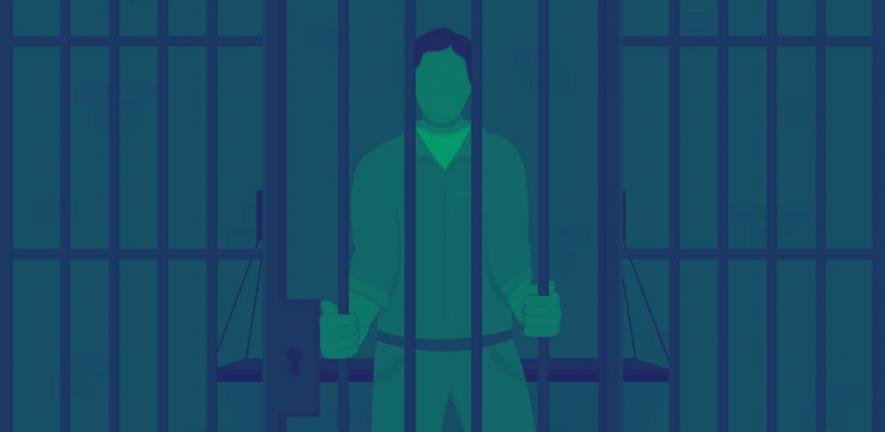80% of 'Unnatural Deaths’ Among Prisoners Are Suicides, Govt Needs to Pay Heed to Mental Health of Prisoners

Image credit: The Leaflet
In 2021, four out of every five deaths due to “unnatural causes” in Indian prisons were suicides.
These shocking numbers are revealed in The Prison Statistics India (PSI), 2021, the National Crimes Record Bureau’s latest report on prisons and their administration.
The report places suicide under the category of “unnatural deaths”’ and identifies certain common modes of suicide by prison inmates.
According to the report, of the 2,116 prisoners that died in custody in the year 2021, 185 deaths were due to “unnatural causes”, with suicide being the overwhelming cause of such deaths, leading to 150 deaths.
Uttar Pradesh reported the highest numbers of deaths due to suicide. As many as 34 prisoners committed suicide in the state in 2021.
As per a report by the Commonwealth Human Rights Initiative (CHRI), based on the PSI data of 2019, suicide rates among inmates is more than twice of what is recorded among the general population in the country.
With a view to mitigate deliberate self-harm and suicides by prisoners in judicial custody, the National Human Rights Commission (NHRC), headed by Justice Arun Mishra, issued an advisory on June 19.
The 21-page advisory directs states and Union territories to take necessary steps and submit reports on action taken to prevent suicides and self-harm among prisoners within a period of three months.
It notes the high percentage of “unnatural deaths” in prisons, with suicide being the leading cause for such deaths— 80 per cent. According to the advisory, medical and mental health issues are among the several factors leading to attempts of suicide in prisons.
The NHRC highlights that since prison authorities are responsible for protecting the health and safety of inmates, the high suicide rate constitutes a violation of human rights.
We are listing the broad themes of the advisory. The Leaflet also spoke to some experts to get their views on the importance and feasibility of each of the themes, and suggestions to make directions in the advisory work better.
Measures Suggested by the Advisory
The broad measures to be taken by the prison authorities across India to curb death by suicide, as per the advisory, are as follows.
Laws and Regulations
The advisory recommends that state governments and prison administrations comply with laws and regulations on mental health, particularly the provisions of the Mental Healthcare Act, 2017 and the Mental Healthcare (Rights of Persons with Mental Illness) Rules, 2018.
It also advises that every state and Union territory identify at least one prison for setting up a mental health establishment.
Under the provision, the medical officer of the prison is mandated to send a quarterly report on the number of prisoners with mental illness to the Mental Health Review Boards (MHRBs). Further, the boards are authorised to visit the prisons and ensure that prisoners with mental illnesses are provided treatment.
According to an article in The Print, only three states— Tripura, Uttarakhand and Himachal Pradesh— have constituted MHRBs.
Adequate and Competent Prison Staff
The Schedule of the Mental Healthcare (Rights of Persons with Mental Illness) Rules provides for one doctor, two nurses and four counsellors for every 500 prisoners.
Reportedly, as of July 2021, 21 states do not have any psychologists or psychiatrists in prisons, and there is one psychologist or psychiatrist for every 16,503 prisoners.
The NHRC advises filling up the existing vacancies of prison staff, including prison welfare officers, probation officers, psychologists and medical staff, and to review the strength of the staff every five years.
According to the India Justice Report of 2022, the vacancies of qualified doctors in prisons rose from 37 percent in 2019 to 48 percent in 2021. The report notes that in 11 states, there is one doctor for 1,000 inmates, whereas five other states and Union territories have no doctors in prisons.
The report also notes that as against the sanctioned strength of 69 psychologists or psychiatrists for 1,319 prisons and 5.5 lakh inmates in 2021 across the country, data shows that only 33 such psychologists have been engaged.
As per the report, 24 states and Union territories have failed to make any provision for a psychologist within the unit of their correctional staff.
It stresses the promotion of basic mental health literacy among prison staff, particularly in administering psychological first aid— to identify, understand and respond to the first signs of mental illnesses and substance abuse disorders, and in providing cardiopulmonary resuscitation and first aid to prisoners who have inflicted self-harm.
The NHRC advises that mental health screening of prisoners be made a mandatory part of their initial screening, to be performed by mental health professionals or available medical staff.
In August 2018, the Telangana Prison Department conducted India’s first psychological screening of the mental health of prisoners at the Sangareddy district jail.
As per the reports of the screening, almost 25 percent of those screened had anxiety and around 51 percent suffered from mania.
Dr Vijay Raghavan, a professor with the Centre for Criminology and Justice at Tata Institute of Social Sciences (TISS), Mumbai and project director of its field action project that facilities legal and rehabilitation justice, Prayas, described “an important body like the NHRC” taking cognisance of mental health problems faced prisoners “as a good first step”.
“Concerted attempts” need to be made “to formulate strategies” to close the gap between NHRC’s “constructive suggestions” and the practices in Indian prisons, he stated.
Madhurima Dhanuka, programme head of the prison reforms programme of the CHRI, also described the NHRC advisory as “a welcome initiative”, especially since the number of prisoners with mental illness has jumped from 5,203 persons in 2015 to 9,180 persons in 2021, as per the 2021 Prison Statistics India.
She cautioned that we need “more than mere advisories and guidelines to improve things on the ground”.
The gap between the cup and the lip is evident in the continuing vacancies in sanctioned posts for psychologists and psychiatrists in as many as 24 states and Union territories, she stated. The shortage was also highlighted by Dr Raghavan.
Monitoring and Training of Prisoners
The advisory provides for two levels of monitoring of prisoners, to identify prisoners at risk of self-harm, and to prevent them from inflicting harm on themselves and committing suicides.
On the first level, it recommends regular observation of inmates and ensuring their telephonic contact with friends and family. It recommends installing an adequate number of telephones in every prison.
On the second level, the advisory recommends shifting high-risk prisoners to premises that provide monitoring through CCTV cameras, prevent access to any material that could be used for suicide and secure a location where suicide was attempted for investigation.
Section 103 of the Mental Healthcare Act provides for the transfer of a prisoner with mental illness to the psychiatric ward of the medical wing of the prison or a mental health establishment, as the case may be.
The NHRC advises adoption of the Gatekeeper Model devised by the World Health Organisation, where selected prisoners are trained to identify other prisoners who may be at risk of committing suicide. It underlines the need to ensure at-risk prisoners are not mistreated by fellow inmates and prisoners are sensitised through mental health programmes.
The NHRC also suggests that select prisoners be trained in providing cardiopulmonary resuscitation and first aid, so that they can be the first responders in case a prisoner has inflicted self-harm or attempted suicide.
Safety Measures
The NHRC recommends seven pointers as “housekeeping” measures to prevent prisoners from committing suicide; keeping abrasive and corrosive chemicals and tools for building beyond the reach of prisoners; regularly checking blankets and bedsheets of inmates for objects that might be used in self-harm; identifying areas that might be suitable for committing suicide and installing CCTV cameras in those areas; keeping the barracks and toilets free from objects used for suicide by hanging; and designing toilet doors in a manner that allows keeping vigil while ensuring privacy.
On the issue of addiction among prisoners, the NHRC advises regular visits of mental health care professionals and de-addiction experts, pointing out that the issue should be seen as a matter of health and rehabilitation and not as a matter of security.
Visitor System and Other Facilities
The NHRC recommends reducing the waiting time of meetings with prisoners to ensure emotional support for prisoners. It supports the use of e-mulakat and the national prisons information portal to enable visitors to book prior appointments.
It advises that rules relating to searches should be followed and visitors should be treated with courtesy by prison officials.
Dr Raghavan recommended starting pilot projects where counsellors and trained social workers are appointed, particularly in a few, large prisons that are overcrowded and where mental health problems are likely faced due to strained infrastructure and human resources.
He gave the example of Galabhet, a successful project in Maharashtra prisons, where prisoners are allowed to meet their minor children in an open space inside the prison.
“When the identity of prisoners is snatched away and reduced to an undertrial or convict number, the weakening family ties and the inability of families to visit often causes the mental breakdown of the inmates,” he added.
On improving the prison environment for inmates, the NHRC advisory states that prisoners should be provided with life skill-based education and activities, as well as facilities for up-skilling, vocational guidance and means for financial independence.
A 2018 report linked the reduced rates of recidivism in the prisons of Telangana to various skill programmes and counselling introduced in the jails, which also includes Unnati programme, a cognitive, behavioural and skills development programme that conducts counselling for prisoners.
Unnati has been so successful that, as Dhanuka pointed out, on July 6 this year, the Bureau of Police Research and Development— a government body constituted for the training, modernisation and research of Indian police and correctional administration; signed a memorandum of understanding with prison department of Delhi and Osmania University, Hyderabad to conduct the Unnati programme in Tihar jail.
The Way Forward: Involvement of Specialised Organisations
Dr Raghavan underlined the need to engage paramedical staff and trained social workers to identify signs of mental breakdown and provide specialised services to prison inmates.
According to him, it is crucial to involve non-governmental organisations and academic institutions that have been working in these areas to organise mental health sessions or recreational-cum-educational activities in prisons.
He said that it is vital for the Union government to provide resources to the prison department to implement such measures.
To illustrate, he explained that Prayas, TISS, organises mental health workshops for the prison population with the help of a specialised organisation, the Institute for Psychologically Handicapped.
Dhanuka concurred on the need to involve the civil society to improve the mental health of prisoners.
“Prison walls should not convince us that prisoners are no longer part of our society,” she concluded.
Sarah Thanawala is a staff writer at The Leaflet.
Get the latest reports & analysis with people's perspective on Protests, movements & deep analytical videos, discussions of the current affairs in your Telegram app. Subscribe to NewsClick's Telegram channel & get Real-Time updates on stories, as they get published on our website.
























